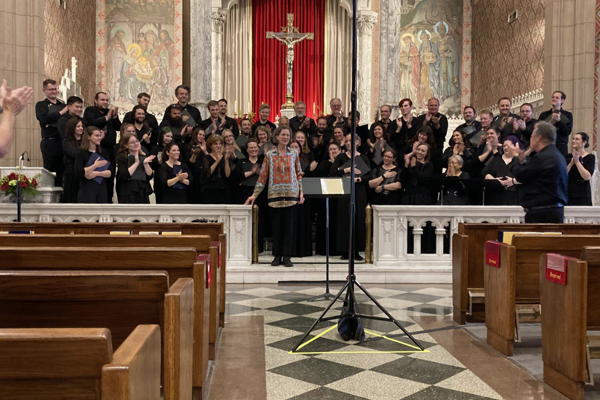
Choral Review: A world premiere, plus a possible US premiere, for Memorial Day weekend by the STL Chamber Chorus
By George Yeh
For some years now, the Saint Louis Chamber Chorus has presented its season-closing concert on the Sunday of Memorial Day weekend. That was the case again this year, with the SLCC’s concert at St. Margaret of Scotland Church, in the Shaw neighborhood. As with several recent SLCC concerts, the venue’s HVAC system was turned off, to allow the chorus’ full dynamic range to register more completely. The indoor temperature remained quite acceptable, except perhaps to those overly enamored of AC. In his opening remarks to the audience before the music began, besides the standard admonishment to turn off all cell phones, SLCC artistic director Philip Barnes spoke of the necessity to experience music live and in person, as opposed to via recordings and even the radio at one remove, with mention of how audiences can truly best appreciate these works at extremes of soft and loud in the same space as the musicians themselves. (The audience behavior was quite reasonable regarding cell phones, as I heard only one message vibrate signal at very low volume during the concert, in the second half.)
One thread running through several works in this concert, on the theme of “Death to Life”, was the idea of a “savior”. In much European choral music, that savior refers to Jesus Christ, as was the case in the opening selection, “Salvator Mundi” (‘Savior of the World’) by Thomas Tallis (c. 1505-1585), which received a very fine reading in its first SLCC performance in 20 years. Mr. Barnes then briefly discoursed on the contrast between the SLCC’s use of multiple singers per vocal line, compared to the one voice per vocal line approach of the celebrated British early music vocal group The Tallis Scholars, saying that there’s room for both types of ensemble with Tallis’ music (but stating also that Tallis himself would have expected larger groups as a rule, with multiple singers per line).
The concert’s second work went from Thomas Tallis to a lament for Tallis by one of his pupils, William Byrd (1543-1623), “Ye sacred Muses (in memoriam Thomas Tallis)”, a work originally for solo voice and instrument(s), but performed here with a 53-strong chorus and no lute or any other instrument, after an 11-season absence from SLCC programs. Mr. Barnes thus conceded that this performance definitely was in the historically “inauthentic” camp. Not being familiar with the solo version, this choral version sounds effective on its own terms, with the three lines of text, quite possibly penned by Byrd himself, flowing nicely between the four vocal ranges (soprano, alto, tenor, bass, or “SATB” in common choral shorthand).
The next selection brought the afternoon’s first “novelty”, the first SLCC performance of “O Saviour of the World” by the British composer, clergyman, and music manuscript collector (notably of works by Handel) Frederick Ouseley (1825-1889). Ouseley was certainly a new name to me, and probably to most in the audience. I found his selection OK, and worth a listen, even if it didn’t really strike me as a neglected gem. One nice surprise was the very low bass tones of its ending.
The next work, however, had much more to say. This was “Ode to a Savior”, the second commission by the SLCC from Kerensa Briggs (born 1991), the SLCC’s newest composer-in-residence, and thus also the second world premiere of her music by the SLCC this season. “Ode to a Savior” sets the sixth and last of the choral odes that occur in Sophocles’ play “Antigone” (the last of Sophocles’ “Oedipus” trilogy) in a fresh translation by Mr. Barnes. “Ode to a Savior” was the outlier among all the selections on the program, in that its text relates to a secular, theatrical drama, as opposed to a Bible-based text or a non-narrative poem without any specific storyline. From a reading of the words alone, Mr. Barnes’ translation does not follow any sort of strict metrical, syllabic, or rhyming schemes, but neither is it formless and without structure where anything goes. Based on just this one hearing, a phrase used by the British music scholar Michael Kennedy to describe Richard Strauss’ music for his opera “Der Rosenkavalier” came to mind, namely the idea of a “flowing melodic conversational recitative”. Examples of Ms. Briggs’ skill in deploying the choral forces were her use of two tenor voices at the very beginning, and three female voices at the start of the third stanza, indicative of the variety of vocal texture throughout the work. Given the prose poem-like character of the words, the text and Ms. Briggs’ music work very well together, where her music allows ample room for the words to register and their pacing to breathe and flow naturally.
Mr. Barnes noted that a classics conference is planned for April 2024 at Washington University, at which choral performances of SLCC-commissioned settings of several of these choral odes are scheduled. For the record, this looks to be the 2024 meeting of the Classical Association of the Middle West and South. Ms. Briggs’ choral ode is a fine work that deserves to be heard again, and will make for an interesting revisit in the context of the other “Antigone” ode settings to date, particularly given the involvement of three different composers (the other two being Ned Rorem and Sasha Johnson Manning) who all presumably operated independently of each other.
Ms. Briggs’ work was the first of three works by past and present SLCC composers-in-residence on this program, where these three composers happen to be women. The second such selection, and the fifth work on the program, was “Waves of Gallipoli” by Melissa Dunphy (born 1980), an SLCC commission from three seasons back, premiered in late 2019 just before the COVID-19 pandemic. This was the concert’s one work with some sort of connection to the general theme of Memorial Day. However, this work approaches from an oblique angle away from America, as it clearly refers to the 1915 Gallipoli campaign of World War I, one of the very worst military disasters in British history, with tremendous casualties and essentially no military gain worth noting. Ms. Dunphy selected epitaphs from the graves of five fallen ANZAC soldiers (from Australia and New Zealand), framed by lines from Leon Gellert (1892-1977), an Australian poet and survivor of the Gallipoli campaign. For a text based on such horrific history, Ms. Dunphy’s work is actually quite restrained, never trying to approximate the volume of combat. Instead, she employs understated effects like whispering and melisma, and resists any temptation to over-sentimentalize the words.
Mr. Barnes mentioned a personal connection to this work, as his ancestor Private Douglas Gray, a member of the Manchester Regiment in the British Army, died in battle during the Gallipoli campaign at the Third Battle of the Krithia Vineyard in August 2015. He showed the front cover of the short score to the audience and invited the audience to look during intermission at the score cover, which is of this picture from the collection of the Imperial War Museum. The picture showed soldiers from – of all regiments – the 6th Battallion, Manchester Regiment, during the Third Battle of the Krithia Vineyard. According to Mr. Barnes, however, Ms. Dunphy chose the photograph simply because it looked appropriate on its own to symbolize “the fog of war”, with no awareness of the provenance of the soldiers or the regiment shown in the photograph. In other words, according to Mr. Barnes, by sheer chance and near-impossible coincidence, Private Douglas Gray may have been one of the soldiers in that photograph.
The concert’s sixth work, just before intermission, was a memorial piece for a very different and much more recent occasion. This work was “Who Shall Separate Us?” by Sir James MacMillan (born 1959), which he composed at the request of the Dean & Chapter of Westminster back in 2011-2012 as an eventual funeral anthem for Queen Elizabeth II. Westminster Abbey had advised Mr. MacMillan that a passage from Romans 8, from St. Paul’s Epistle to the Romans, that begins “Who shall separate us from the love of Christ?” was one of Elizabeth II’s favorite Biblical passages. The work starts notably with a low drone, but then becomes quite extrovert and energetic, rather than mournful or dour. It is almost as if to say: “Let us not be sad that she is no longer, but instead let us be grateful that she was”. As the text is not specifically tied to Queen Elizabeth II, this work is suitable for general performances, and well deserves it, based on the very good performance by the SLCC.
As a side note (but related to this review’s header), although Mr. MacMillan stated in a BBC News article from December 2022 that “I'm beginning to hear about performances of the piece all over the world”, a look at the Boosey & Hawkes music publisher page on “Who Shall Separate Us?” indicated a total of 4 official performances to date, all in the UK. I have not traced any indication on-line of any other performances of Mr. MacMillan’s anthem in the USA (or indeed anywhere else) besides these four UK performances. Thus, this past Sunday’s SLCC performance of “Who Shall Separate Us?” may well have been this work’s American premiere, even though the SLCC did not advertise that situation, nor did Boosey & Hawkes mention the SLCC performance under its online performance calendar, either upcoming prior to this Sunday, or after the fact subsequently. It may have been an omission in good faith that the SLCC did not consider this possibility. (If my inference proves incorrect, I will have this review corrected.) Certainly, at the very least, the SLCC gave the first performance of the work in St. Louis. It would be interesting if this indeed proved to be the first performance in the United States.
The second half of this concert featured a single work, the “Requiem” of Sasha Johnson Manning (born 1963), in eight movements, which she composed over the course of her tenure as the SLCC’s first composer-in-residence, from 1998 to 2006, one movement per year. Last performed by the SLCC 15 seasons back, Ms. Manning’s “Requiem” takes about 45 minutes, and is unusual among Requiems in being scored for chorus alone, as opposed to the more standard instrumentation of Requiems for chorus, soloist(s), and orchestra. Celebrated examples of the latter include Requiems of Mozart, Berlioz, Brahms, and Verdi. Moreover, Ms. Manning took a polyglot approach to her work, reaching beyond the Latin text of the standard Requiem Mass to include English-language movements, namely a setting of Psalm 130 (‘Out of the deep’) and poems by Emily Dickinson, Oscar Wilde and Walt Whitman, as well as a selection by the Spanish poet Juan de la Cruz (John of the Cross). Her use of texts in different languages puts her in succession to her compatriot Benjamin Britten’s juxtaposition of the Latin Mass with poems of the British poet and soldier Wilfred Owen in the “War Requiem”. Likewise, her choice of Whitman’s poetry joins her to the distinguished roster of British composers who set Walt Whitman to music, like Frederick Delius, Gustav Holst, and Ralph Vaughan Williams (whose 1907 work “Toward the Unknown Region” uses the same text that Ms. Manning used here).
In overall spirit, Ms. Manning’s “Requiem” is closer to the consolatory spirit of the Requiems of Gabriel Fauré and Maurice Duruflé, although no Requiem would be expected to be “easy listening”, by default of its subject matter. The one movement that would most call for fire-and-brimstone terror is the 2nd movement ‘Dies Irae’ (‘Day of Wrath’), which Fauré and Duruflé omitted from their Requiems, but which Ms. Manning included. However, her approach to the ‘Dies Irae’ is more about enhanced volume and energy, rather than the more apocalyptic, awe-inspiring, and menacing treatments by Berlioz and Verdi. Following her use of the full choir in the first three movements (‘Requiem aeternam’, ‘Dies irae’, Psalm 30), Ms. Manning then splits the choir by gender for the Emily Dickinson (4th movement) and Oscar Wilde (5th movement) settings. Perhaps wryly, she set the Emily Dickinson for male voices and the Oscar Wilde for female voices. In the 6th movement, Ms. Manning juxtaposes the Juan de la Cruz text, his ‘Romança VI’ (about Simeon’s late-in-life encounter with Jesus Christ), with the traditional Latin text “Nunc dimittis”, with the ladies singing the Spanish text and the men the Latin. Interestingly, at least to this listener, Ms. Manning’s music with the Spanish text felt notably quite extrovert and outgoing. The 7th movement, the setting of Whitman, ‘reunites’ the choir, as it were, to sing one text, which begins “Darest thou now, O Soul / Walk out with me toward the Unknown Region”. The 8th and final movement returns to the Latin text, in a setting of ‘Lux aeterna’ (‘Eternal light’), following immediately from the end of the 7th movement (‘attacca’) without pause, as if to indicate the nature of the “Unknown Region”. This closing movement has a very flowing ethos, and even restful, somewhat reminiscent in spirit to this listener of the close of Vaughan Williams’ “A Sea Symphony”, where both works generate a mood of calm acceptance of the end. In that sense, with that restful ethos at the concert’s close, perhaps the path of the concert didn’t truly follow the path of “Death to Life”, except perhaps in the sense that Requiems, while commemorating the dead, also are consolation to the living who mourn those lost.
Ms. Manning was present in St. Louis to take the warmly appreciative applause after the conclusion of her “Requiem”. There was no encore, undoubtedly the proper choice to leave the audience in a reflective mood. The SLCC showed sterling work throughout the afternoon, with Mr. Barnes conducting the entire concert without ceding any of the selections to either of the SLCC’s assistant conductors. This concert marked the SLCC’s return to St. Margaret of Scotland Church after a two-decade absence. The acoustic of St. Margaret of Scotland Church is very fine indeed (a first-time visit for this reviewer), and well worthy of future concerts, hopefully sooner than another 20 years. This concert was fully satisfying and made for a strong conclusion to the SLCC’s current season.




